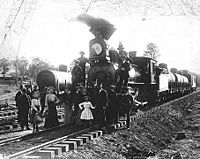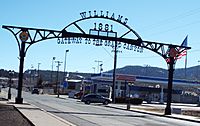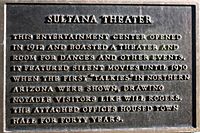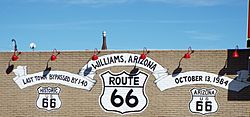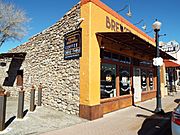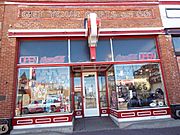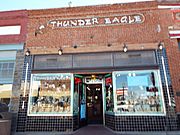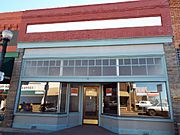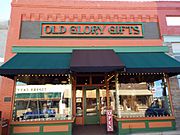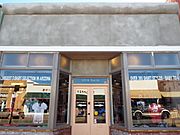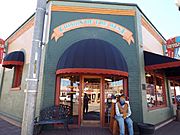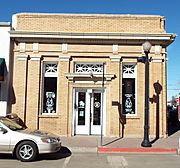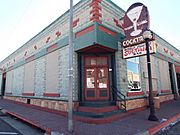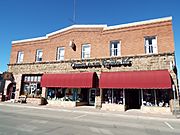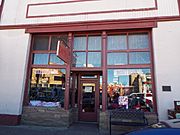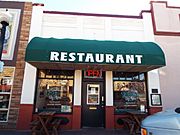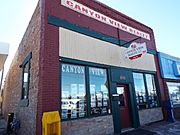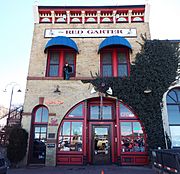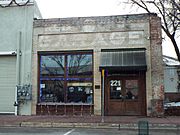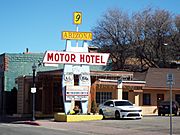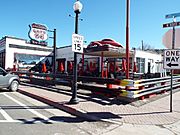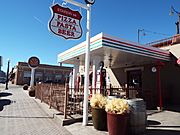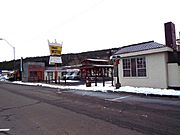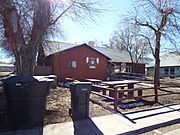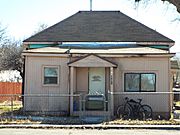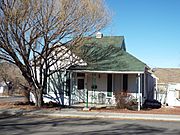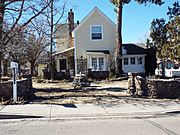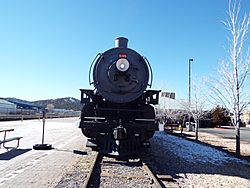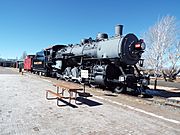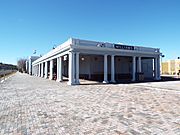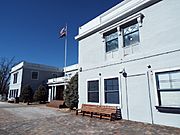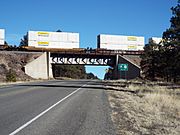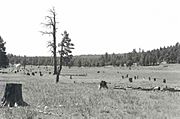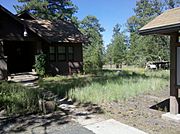List of historic properties in Williams, Arizona facts for kids
Quick facts for kids
List of historic properties
in Williams, Arizona |
|
|---|---|
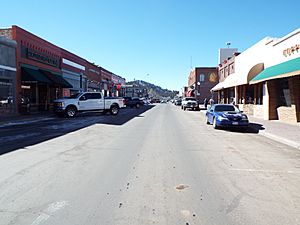
Historic Urban Route 66
|
|
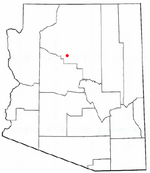
Location of Williams in Coconino County, Arizona
|
This article shares a list and photos of old buildings, homes, bridges, and monuments in Williams, Arizona. Some of these special places are even listed on the National Register of Historic Places (NRHP). You'll also learn about the Grand Canyon Locomotive No. 539, a train built in 1917, which you can find at the Williams Santa Fe Depot.
Contents
A Quick Look at Williams' History
The area where Williams is today was once home to the Cohonina people. They were early ancestors of the Hopi people, and because of this, the land is considered very special.
In 1876, the first settlers who were not Native-American arrived. They were ranchers from Europe who raised cattle and sheep. In 1881, the town was named "Williams" to honor William Sherley "Old Bill" Williams. He was a famous mountain man and frontiersman, which means he explored and lived in the wild. Even though "Old Bill" never lived in Williams, a river and a mountain were also named after him.
In 1980, an 8-foot-tall bronze statue of "Old Bill" was put up in Bill Williams Monument Park. The town grew, and soon it had its own post office.
Fires and Rebuilding
Williams faced many challenges, including four big fires. The first fire in 1884 destroyed 36 businesses, 2 hotels, and 10 homes. More fires happened in 1901 and 1903. The 1903 fire ruined six saloons, one restaurant, and two homes. The fourth fire in 1908 burned a whole city block and 10 homes.
The Tetzlaff Building was one of the few buildings that survived three of these fires. This was because it was made of strong brick, unlike most other buildings which were made of wood. August Tetzlaff, a German immigrant, built it in 1897.
Williams officially became a town on July 9, 1901. The main streets in the business area were named Railroad and Bill Williams. The streets in the neighborhoods were named after famous American Civil War generals.
The "Gateway to the Grand Canyon"
In 1901, the same year Williams became a town, the Williams and Atchison, Topeka & Santa Fe Railway extended its train line. This new line went from Williams all the way to the South Rim of the Grand Canyon. This made Williams known as the "Gateway to the Grand Canyon." This nickname first appeared in the Williams News newspaper in 1901. The train line brought many more tourists to the area. In 1908, the Fray Marcos Hotel, a historic Harvey House, opened next to the Williams Santa Fe Depot.
Many saloons were located on Railroad Avenue. The town government decided to keep these entertainment spots in one area, which became known as "Saloon Row." The Tetzlaff and Cabinet Saloon buildings are the oldest ones from this area. Both of them survived the 1908 fire.
Route 66 and Modern Times
The famous Route 66 was finished in 1926 and runs right through Williams. This highway helped the town grow a lot. Many people moving west or just traveling for fun would stop and visit Williams. Because of this, many motels were built, like the Motor Hotel and the 9 Arizona Motor Hotel.
On October 13, 1984, Interstate 40 opened, going around the town. This usually means towns get forgotten, but Williams made a deal. The state built three exits to Williams, which helped the town avoid being abandoned. Route 66 was officially closed the next year.
The Arizona Memory Project, with help from the Williams Public Library and Kaibab National Forest, has old photos of Williams. These pictures show early ranching, logging, train activity, and the people and places of Williams.
What is a Historic Place?
A property listed on the National Register of Historic Places means it's important to history. However, it doesn't always stop an owner from changing or even tearing down their building. Jim McPherson, from the Arizona Preservation Foundation, explains that private owners have the right to do what they want with their property.
Williams has two special historic areas called "historic districts." These are the Williams Historic Business District and the Williams Residential Historic District. Some properties in the Kaibab National Forest near Williams are also on this list.
Williams Historic Business District
This district includes many old buildings in the heart of Williams. It covers the area between Grant and Railroad Avenues, and 1st and 4th Streets. This area was added to the National Register of Historic Places on December 20, 1984.
A part of Bill Williams Avenue, between 6th Street and Pine Street, was also listed separately as the Urban Route 66 on May 19, 1989. Some buildings, like the DelSue Motor Inn, the Williams Santa Fe Depot, and the Grand Canyon Railway, are also listed individually.
Even within a historic district, not every single building is considered "historic" on its own. And private owners can still change their buildings. However, many buildings in the district are recognized as important parts of Williams' history.
Buildings in the Business District
Here are some of the historic buildings you can see in the Williams Historic Business District:
- The Babbitt-Polson Warehouse Building – Built around 1890, this is the last warehouse of its kind in Williams. The painted signs on its side tell the story of who owned it over the years.
- The Bowden Building – Built in 1947.
- The Rock Building – Built in 1936.
- The Postal Telegraph/Bennitt Auto Building – Built in 1910.
- The White Horse Trading Co. Building – Built in 1910.
- The Rittenhouse Haberdashery Building – Built in 1910.
- The Grand Canyon Drug Co. Building – Built in 1912.
- The Old Pool Parlor Building – Built in 1910.
- The Lebeach Confectionery Building – Built in 1914.
- The Dime Store Building – Built in 1912.
- The Duffy Brothers Grocery Building – Built in 1912.
- The Citizens Bank Building – Built in 1918. It's made of a light yellow-brown brick.
- The Sultana Theatre Building – Built in 1912, this theater used to show silent movies. Tunnels built by Chinese railroad workers were used to move liquor during the time of Prohibition. The first "talkie" movie in Northern Arizona was shown here in 1930.
- The Pollock Building – The first floor was built in 1901, and the second floor in 1927.
- The Grand Canyon Hotel Building – Built in 1891 by Cormick E. Boyce, a pioneer merchant. It was first known as the Boyce Hotel.
- The Old Williams Fire Station – Built in 1902.
- The Old Williams Post Office Building – Built in 1907.
- The General Store Building – Built in 1907.
- The Adams Grocery Store Building – Built in 1907.
- The Alley Saloon Building – Built in 1910.
- The Tetzlaff Building – Built in 1897, it's in the area once known as "Saloon Row."
- The Cabinet Saloon Building – Built in 1895. This building appeared in the 1988 movie "Midnight Run" and won an award in 1994.
- The Red Cross Garage Building – Built in 1913.
Tourism became very important for Williams. The town offered train service to and from the Grand Canyon. Tourists traveling by car also helped the town's economy. Many service stations and motels were built because of all the visitors. Today, some of these old service stations have become restaurants.
Historic Route 66 Structures
Here are some buildings that were important for car travelers on Route 66:
- The 9 Arizona Motor Hotel – Built in 1923. This motel is considered important enough to be listed on the National Register of Historic Places.
- The Old Mobil Gas Station (now Cruiser's Route 66 Café) – Built in 1930.
- Pete's Gas Station Museum – Built in 1949.
- The Old Texaco Gas Station (now Station 66 Italian Bistro) – Built in 1930.
- The DelSue Motor Inn – This building, from 1936, was a gas station and a place for tourists to stay. It's built in a Spanish Colonial style and is listed on the National Register of Historic Places. It's now called the Grand Motel.
Williams Residential Historic District
The Williams Residential Historic District is an area with many old homes. It includes buildings from the late 1800s to the mid-1900s that still look much like they did when they were built. All these homes show how Williams grew between 1890 and 1941. Some houses even used parts that were made in a factory. This district was added to the National Register of Historic Places on January 8, 1998. Two homes in this district are also listed individually: the First Methodist Episcopal Church and Parsonage, and the Negrette House.
Homes in the Residential District
Here are some of the historic homes you can see in this district:
- The First Methodist Episcopal Church and Parsonage – Also known as the Community United Methodist Church, it was built in 1891. It was listed on the National Register of Historic Places on November 29, 1984.
- The American Legion Clubhouse – Built in 1936.
- The C.E. Boyce House – Built in 1890. Cormick E. Boyce was an important early merchant in Williams. He owned a lot of land and built the Grand Canyon Hotel (first called the Boyce Hotel) in 1892.
- The Henry Cone House – Built in 1892.
- The John Keck House – Built in 1891.
- The Michael Shelley House – Built in 1891.
- The Negrette House – This house was built in 1893 by the Saginaw Mill as a place for workers to sleep and an office. In 1919, the Negrette family bought it. It was listed on the National Register of Historic Places on October 8, 2014.
Grand Canyon Railway
The Grand Canyon Railway started running in 1901. It takes passengers from Williams all the way to the Grand Canyon Village. The train uses old, restored cars and travels through the beautiful Arizona countryside.
Railway Structures
Here are some important places related to the Grand Canyon Railway:
- The Grand Canyon Railway – This historic train line carries people between Williams and the South Rim of Grand Canyon National Park. It was listed on the National Register of Historic Places on August 23, 2000. You can see the Grand Canyon Railway Locomotive No. 539, built in 1917, in Williams.
- The Williams Santa Fe Depot – Built in 1898, this train station is part of the Grand Canyon Railway's historic listing.
- The Fray Marcos Hotel – Built in 1901, this hotel is very important because it was a long-standing Harvey House. It's also included in the Grand Canyon Railway's historic listing.
- The Williams Santa Fe Freight Depot – Built in 1901, this building is now the Williams & Forest Service Visitor's Center.
- The BNSF (formerly Santa Fe Railroad) Overpass – Built in 1957, this bridge goes over Route 66.
The Williams Ranger District of the Kaibab National Forest
The southern part of the Kaibab National Forest is split into two areas: the Tusayan Ranger District and the Williams Ranger District. Many places in this forest were once lived in by the ancient "Cohonina" people. The Williams Region Arizona Site Stewards help protect these important historical sites from damage.
Historic Sites in the Forest
Here are some places and structures in the Williams district of the forest that are listed on the National Register of Historic Places:
- The Barney Flat Historic Railroad Logging Landscape – These are the remains of old railroad logging operations from the early 1900s in the South Kaibab Plateau. Barney Flat is unique because it's the only "stump field" (an area where trees were cut down, leaving stumps) listed on the National Register of Historic Places. It was added on February 24, 1995.
- The Camp Clover Ranger Station – This site includes five buildings (an office, a home, a barn/garage, a shed, and a garage) and a corral. They were built in 1934 by the Civilian Conservation Corps, a program that put people to work during the Great Depression. It was added to the National Register of Historic Places on July 16, 1993.
- Laws Spring – This area in the Kaibab National Forest was also home to the "Cohonina" people between AD 700 and AD 1100. They left behind stone houses, pottery pieces, tools, grinding stones, and rock art. Many Petroglyphs, which are ancient drawings carved into rocks, have been found at Laws Spring. It was listed on the National Register of Historic Places on July 5, 1984.
- Williams section of the Kaibab National Forest
See also
- Kaibab National Forest
- National Register of Historic Places listings in Coconino County, Arizona



